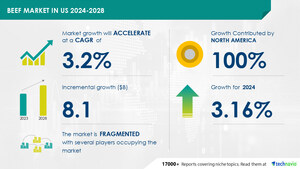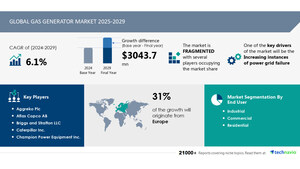NEW YORK, Nov. 14, 2024 /PRNewswire/ -- Report with market evolution powered by AI - The global near autonomous passenger car market size is estimated to grow by USD 962.1 billion from 2024-2028, according to Technavio. The market is estimated to grow at a CAGR of 60.29% during the forecast period. Increasing popularity of semi-autonomous vehicles is driving market growth, with a trend towards increased funding for research and development of autonomous vehicles. However, concerns related to cybersecurity poses a challenge.Key market players include Amazon.com Inc., Bayerische Motoren Werke AG, Chery Automobile Co. Ltd., Chongqing Changan Automobile Co. Ltd., Ford Motor Co., Geely Auto Group, General Motors Co., Honda Motor Co. Ltd., Hyundai Motor Co., Mazda Motor Corp., Mercedes Benz Group AG, NIO Ltd., Nissan Motor Co. Ltd., Tata Motors Ltd., Tesla Inc., Toyota Motor Corp., and Volkswagen AG.
Key insights into market evolution with AI-powered analysis. Explore trends, segmentation, and growth drivers- View Free Sample PDF
Near Autonomous Passenger Car Market Scope |
|
Report Coverage |
Details |
Base year |
2023 |
Historic period |
2018 - 2022 |
Forecast period |
2024-2028 |
Growth momentum & CAGR |
Accelerate at a CAGR of 60.29% |
Market growth 2024-2028 |
USD 962.1 billion |
Market structure |
Fragmented |
YoY growth 2022-2023 (%) |
42.73 |
Regional analysis |
North America, Europe, APAC, South America, and Middle East and Africa |
Performing market contribution |
North America at 37% |
Key countries |
US, Germany, China, Japan, and France |
Key companies profiled |
Amazon.com Inc., Bayerische Motoren Werke AG, Chery Automobile Co. Ltd., Chongqing Changan Automobile Co. Ltd., Ford Motor Co., Geely Auto Group, General Motors Co., Honda Motor Co. Ltd., Hyundai Motor Co., Mazda Motor Corp., Mercedes Benz Group AG, NIO Ltd., Nissan Motor Co. Ltd., Tata Motors Ltd., Tesla Inc., Toyota Motor Corp., and Volkswagen AG |
The Near Autonomous Passenger Car Market is experiencing significant growth due to the development and implementation of advanced technologies such as autonomous, driverless, and self-driving cars. These vehicles utilize sensors, cameras, radar, LiDAR, GPS, and software algorithms for navigation and safety. V2V and V2I communication, semiconductor chips, and automated driving systems are also key components. Battery management systems, energy-efficient and emission-free vehicles like battery electric vehicles, are gaining popularity due to fossil fuel price fluctuations and automotive safety concerns. Advanced safety technologies like parking assistance systems, blind spot detection, and adaptive cruise control are essential. Semi-autonomous and fully autonomous vehicles are the future of passenger cars and commercial vehicles. Mobility services like ride hailing and deep neural networks enhance transportation efficiency. Infrastructural developments and investment opportunities are crucial for the growth of autonomous vehicle technology. However, safety concerns, human error, cybersecurity threats, and technological challenges remain significant hurdles. Level 3 systems offer a balance between human control and automation, while consumer acceptance and traffic accidents are ongoing considerations.
The near autonomous passenger car market is witnessing substantial investment from key players, including automotive manufacturers, Tier-1 suppliers, and technology providers. Companies like Mercedes Benz and Ford Motor are leading the charge, collectively investing approximately USD50 billion in autonomous vehicle technology development. Automakers have primarily focused their investments on specialized technological firms. For instance, General Motors committed USD35 billion towards EV and AV technology from 2020 to 2025. These investments aim to position companies at the forefront of the autonomous vehicle market.
Request Sample of our comprehensive report now to stay ahead in the AI-driven market evolution!
• The Near Autonomous Passenger Car Market is experiencing significant growth with the development of advanced technologies such as sensors, cameras, radar, LiDAR, GPS, and software algorithms. Autonomous, driverless, and self-driving cars are revolutionizing the transportation industry. However, challenges remain, including the integration of V2V and V2I communication, semiconductor chips, automated driving systems, battery management systems, and energy-efficient and emission-free vehicles. Factors like fossil fuel prices, automotive safety, and road accidents push the demand for advanced safety technologies like parking assistance systems, blind spot detection, and adaptive cruise control. Semi-autonomous and fully autonomous vehicles are the future of mobility services, with ride hailing services leading the way. Deep Neural Networks and AI systems are essential for transportation efficiency and infrastructural developments. Safety concerns, human error, and cybersecurity threats are significant challenges. Level 3 systems are gaining consumer acceptance, but technological challenges remain. Investment opportunities lie in the development of autonomous vehicle technology and self-driving technologies. The market is vast, with applications in passenger cars, commercial vehicles, and mobility services.
• Modern near autonomous passenger cars incorporate numerous electronic control units (ECUs) and connectivity features, increasing the risk of security breaches. Hackers have successfully infiltrated the operations of connected vehicles, posing a significant threat to autonomous cars. Unlike traditional vehicles where a driver maintains full control, autonomous vehicles rely solely on machine intelligence and sensors. This shift in control heightens the vulnerability to cyber-attacks, making it crucial for automakers to prioritize security measures to safeguard these advanced vehicles.
Discover how AI is revolutionizing market trends- Get your access now!
This near autonomous passenger car market report extensively covers market segmentation by
- Technology
- 1.1 ADAS level 1
- 1.2 ADAS level 2
- Geography
- 2.1 North America
- 2.2 Europe
- 2.3 APAC
- 2.4 South America
- 2.5 Middle East and Africa
1.1 ADAS level 1- Advanced Driver-Assistance Systems (ADAS) are technological innovations that enhance driving and parking capabilities for vehicles. These systems promote safety by utilizing secure human-machine interaction and employing sensors, cameras, and automated technology to detect and respond to environmental impediments or driver errors. ADAS enables varying levels of autonomous driving, with level 1 allowing vehicles to steer, accelerate, and brake independently under most conditions. This technology is crucial for understanding other vehicles' behavior and navigating roads safely, either independently or in conjunction with other vehicles. ADAS level 1 acts as a foundational technology for future autonomous vehicles, fueling the growth of the global near autonomous passenger car market during the forecast period.
Download a Sample of our comprehensive report today to discover how AI-driven innovations are reshaping competitive dynamics
The Near Autonomous Passenger Car Market refers to the rapidly evolving sector of self-driving cars, also known as autonomous or driverless vehicles. These advanced technologies utilize sensors, cameras, radar, LiDAR, GPS, and software algorithms to enable vehicles to navigate roads with minimal human intervention. V2V and V2I communication systems facilitate vehicle-to-vehicle and vehicle-to-infrastructure communication, enhancing safety and efficiency. Semiconductor chips and automated driving systems power these advanced features, while battery management systems ensure energy efficiency and the potential for emission-free vehicles. Self-driving technologies offer mobility and accessibility benefits, particularly for independent transport. However, safety concerns persist due to human error and the need for cyber security measures. Level 3 systems represent a significant step towards full autonomy, but technological challenges remain.
The Near Autonomous Passenger Car Market is a rapidly evolving sector, driven by advanced technologies such as sensors, cameras, radar, LiDAR, GPS, and software algorithms. These technologies enable vehicles to perceive their environment and make real-time driving decisions. Autonomous cars, also known as driverless or self-driving cars, use V2V and V2I communication to share data with other vehicles and infrastructure. Semiconductor chips and automated driving systems are essential components, while battery management systems ensure the efficiency and longevity of energy-efficient and emission-free vehicles, such as battery electric vehicles. Fossil fuel prices and automotive safety are significant factors influencing the market. Advanced safety technologies, including parking assistance systems, blind spot detection, and adaptive cruise control, are becoming standard features. Semi-autonomous and fully autonomous vehicles are transforming transportation, offering mobility services and independent transport. However, safety concerns, human error, cyber security threats, and technological challenges remain. Infrastructural developments and investment opportunities in autonomous vehicle technology and self-driving technologies are crucial for the market's growth. Ride hailing services and deep neural networks are also playing a role in transportation efficiency. Despite these advancements, consumer acceptance and regulatory frameworks are essential for widespread adoption. The market for near autonomous passenger cars is poised for significant growth, offering numerous opportunities for innovation and progress.
1 Executive Summary
2 Market Landscape
3 Market Sizing
4 Historic Market Size
5 Five Forces Analysis
6 Market Segmentation
- Technology
- ADAS Level 1
- ADAS Level 2
- Geography
- North America
- Europe
- APAC
- South America
- Middle East And Africa
7 Customer Landscape
8 Geographic Landscape
9 Drivers, Challenges, and Trends
10 Company Landscape
11 Company Analysis
12 Appendix
Technavio is a leading global technology research and advisory company. Their research and analysis focuses on emerging market trends and provides actionable insights to help businesses identify market opportunities and develop effective strategies to optimize their market positions.
With over 500 specialized analysts, Technavio's report library consists of more than 17,000 reports and counting, covering 800 technologies, spanning across 50 countries. Their client base consists of enterprises of all sizes, including more than 100 Fortune 500 companies. This growing client base relies on Technavio's comprehensive coverage, extensive research, and actionable market insights to identify opportunities in existing and potential markets and assess their competitive positions within changing market scenarios.
Technavio Research
Jesse Maida
Media & Marketing Executive
US: +1 844 364 1100
UK: +44 203 893 3200
Email: [email protected]
Website: www.technavio.com/
SOURCE Technavio

WANT YOUR COMPANY'S NEWS FEATURED ON PRNEWSWIRE.COM?
Newsrooms &
Influencers
Digital Media
Outlets
Journalists
Opted In





Share this article